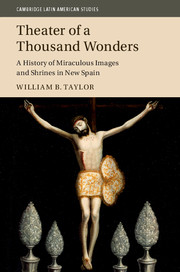Book contents
- Frontmatter
- Dedication
- Contents
- List of Figures
- List of Maps
- List of Tables
- Preface and Acknowledgments
- Archive Abbreviations
- Introduction
- Part I Bearings: Historical Patterns and Places of Image Shrines
- Part II Soundings: Divine Presence, Place, and the Power of Things
- Conclusion
- Appendix 1 Colonial Image Shrines
- Appendix 2 When Shrines Began
- Appendix 3 Other Saints
- Index
Conclusion
Published online by Cambridge University Press: 05 September 2016
- Frontmatter
- Dedication
- Contents
- List of Figures
- List of Maps
- List of Tables
- Preface and Acknowledgments
- Archive Abbreviations
- Introduction
- Part I Bearings: Historical Patterns and Places of Image Shrines
- Part II Soundings: Divine Presence, Place, and the Power of Things
- Conclusion
- Appendix 1 Colonial Image Shrines
- Appendix 2 When Shrines Began
- Appendix 3 Other Saints
- Index
Summary
By the turn of the seventeenth century, Catholic institutions, beliefs, and practices were ingrained features of everyday life and ceremonial occasions in New Spain, as imperial authorities and evangelizers intended. Christianity provided an increasingly diverse populace with an outlook on life and practices that complemented, but proved more durable than, the hierarchy of colonial political offices and administrators. A lasting sense of enchantment, of divine immanence in the present, was part of what most people shared as New World Catholics, along with a hunger for epiphanies in daily life and personal salvation. A great many shrines would come to feed this hunger as long-lived sites of shared devotion and contestation across social groups in many places. Shrines were understood to be havens of divine protection and sources of well-being – “Little heavens on earth,” Francisco de Florencia called them – but this was not the sunlit enchantment of the Garden of Eden before the Fall. Satan was immanent, too. For Spaniards in America, he and his demon minions were fully present, deceiving the native population into idolatry and corrupting the ignorant, gullible, and devious of all classes, at every turn. Native Mesoamericans’ monistic views of divine power and presence as simultaneously nurturing and destructive could lead them to propitiate Satan as well as Christ and the saints, for the superhuman powers attributed to him by Catholic pastors and local adepts. And people labeled “castas,” often without a secure place in the social and legal order, were especially likely to be suspected of pacts with the devil and overrepresented for that reason in the Inquisition's investigations into satanic worship. Not surprisingly, exorcisms remained a familiar feature of Catholic practice throughout the colonial period.
The hold of miracles on the imagination settled on sacred things, especially images of Christ and the Virgin Mary, and the patina of time usually added to their store of wonder. Through age, use, and reputation, they were rooted in local time that transcended chronology in the marks of loving devotion by untold numbers of forebears, legendary origins in a distant past, and miracles both remote and recent. Catholicism's ways of expressing faith in an incarnate God were wellsprings of the charisma of shrine images and sites, valorizing intense feelings of contrition and love and embracing the power and uses of things.
- Type
- Chapter
- Information
- Theater of a Thousand WondersA History of Miraculous Images and Shrines in New Spain, pp. 551 - 566Publisher: Cambridge University PressPrint publication year: 2016



